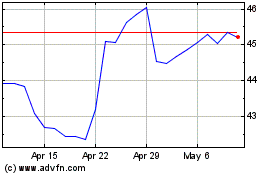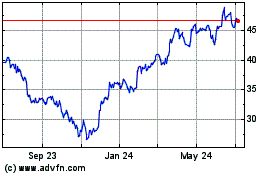GM Runs Full Bore On SUV, Truck Demand -- WSJ
July 22 2016 - 3:03AM
Dow Jones News
By Gautham Nagesh
General Motors Co. posted its best financial quarter in the
seven years since emerging from bankruptcy even as Brexit concerns
have the Detroit auto giant raising a caution flag for the second
half of 2016.
Results for the quarter benefited from a continued shift in the
U.S. to high-margin trucks and sport-utility vehicles from
passenger cars, steady sales increases in China and improved
conditions in Western Europe.
GM's second-quarter operating profit far exceeded analysts'
expectations. Overall profit for the period ended June 30 more than
doubled to $2.9 billion on revenue up 11% to $42.4 billion, both
quarterly postbankruptcy records.
GM also eked out a $137 million gain in Europe, its first in the
region since 2011. But Chief Financial Officer Chuck Stevens
signaled concern about a potential hit to earnings later this year
because of the U.K.'s decision to exit the European Union. Citing a
weakening British pound and softening of U.K demand, the company
estimates $400 million in potential second-half impact because of
Brexit, possibly knocking GM off its goal of reporting black ink in
Europe on an annual basis for the first time since 1998.
"The Brexit vote has created a potentially significant
headwind," Mr. Stevens said when discussing earnings on Thursday.
But he reiterated the auto maker still aims to meet its profit
projection. "This is a speed bump along the way that we're going to
deal with." Cost cuts and pricing changes could soften Brexit's
blow, he said.
Missing the European profit target would be a rare misstep for
Chief Executive Mary Barra, who took the helm in 2014 on the eve of
the disclosure of a major vehicle-safety crisis. With that
ignition-switch episode largely in the rearview mirror, Ms. Barra
has consistently asked investors to judge her by results and not by
lofty projections.
GM's global operating margin of 9.3% last quarter indicates the
company is on track to meet its longer-term profit goals. GM shares
were up 1.7% at $32.03 at 4 p.m. in New York trading on
Thursday.
Second-quarter results benefited from $3.6 billion in operating
profit in North America on GM's sharp increase in high-margin truck
and sport-utility production, a move aimed at stocking dealer lots
ahead of the summer selling season. GM books revenue and profit at
the point of production, a strategy that allowed the company to
offset concerns about the sizable amount of market share it lost in
the period compared with the same quarter in 2015.
GM's North American earnings represented 90% of global operating
profit for the quarter, and the region's 12.1% operating margin was
a key factor driving global results and a 25-cent-a-share increase
in its 2016 earnings estimate. Continued growth in China -- GM's
largest sales market -- also boosted optimism.
Fearing a peak in U.S. light-vehicle demand, however, Ms. Barra
has aggressively retooled for the future. The early months of 2016
included significant investment announcements, including a $500
million stake in ride-sharing firm Lyft Inc. Ms. Barra declined to
say whether GM will participate in additional funding rounds, but
said the "alliance" has met expectations this far.
The company on Thursday said in a regulatory filing its deal to
purchase Silicon Valley autonomous-car developer, Cruise Automation
Inc., was valued at nearly $700 million when it closed in May. That
sum includes certain retention bonuses for certain Cruise
employees, but doesn't reflect other undisclosed performance awards
tied to technology and commercialization milestones.
Speaking to analysts, Ms. Barra said GM was drawn to Cruise by
its expertise in machine learning and artificial intelligence, two
areas considered crucial to the development of fully autonomous
vehicles. GM engineers, including those acquired in the Cruise
deal, are testing autonomous Chevrolet Bolt electric cars in San
Francisco.
Edward Jones senior equity analyst Jeff Windau said GM's
management team is executing "very well" amid favorable market
conditions. Low fuel prices have ratcheted up demand for the
heavier and pricier light trucks that represent Detroit's sweet
spot, and low industry inventories have limited the need for
incentives.
He said softening demand in the U.S. could impact GM's ability
to maintain its discipline on pricing. Weakness in South America
and uncertainty in Europe -- fueled partially by Brexit -- presents
risks. GM posted an operating loss of $121 million in South America
last quarter, where economic turmoil has hurt its business by
economic woes in Venezuela and Ecuador and the impact of the strong
U.S. dollar.
GM also said in a regulatory filing on Thursday that it could be
forced to eventually recall an additional 4.3 million vehicles
equipped with Takata Corp. air bags, leading to costs totaling $550
million. The components are part of a wider industry recall of tens
of millions of Takata air bags that run the risk of rupturing and
spraying shrapnel into a vehicle's cabin.
--Mike Spector and John D. Stoll contributed to this article
Write to Gautham Nagesh at gautham.nagesh@wsj.com
(END) Dow Jones Newswires
July 22, 2016 02:48 ET (06:48 GMT)
Copyright (c) 2016 Dow Jones & Company, Inc.
General Motors (NYSE:GM)
Historical Stock Chart
From Mar 2024 to Apr 2024

General Motors (NYSE:GM)
Historical Stock Chart
From Apr 2023 to Apr 2024
